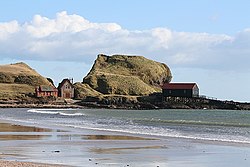Dunaverty Castle
| Dunaverty Castle | |
|---|---|

The site of Dunaverty Castle
|
|
| Coordinates | 55°18′27″N 5°38′41″W / 55.3075°N 5.6447°WCoordinates: 55°18′27″N 5°38′41″W / 55.3075°N 5.6447°W |
Dunaverty Castle is located at Southend at the southern end of the Kintyre peninsula in western Scotland. The site was once a fort belonging to the Clan Donald (MacDonald). Little remains of the castle, although the site is protected as a scheduled monument.
The remains of Dunaverty Castle stand on a rocky head land on the south east corner of Kintyre, Scotland. The headland it was built on forms a natural stronghold with the sea on three sides and is only approachable from the north. It is attached to the mainland only by a narrow path. It is known that the castle itself was accessed by a drawbridge.
In 1248, Henry III, King of England allowed Walter Byset to buy stores from Ireland for Dunaverty Castle which he had seized and was fortifying, apparently in revenge for hospitality given by Alexander II, King of Scotland to certain English pirates. However during that same year the castle was taken by Allan, the son of the Earl of Atholl, and Byset was taken prisoner.
In 1263, Dunaverty Castle was garrisoned by Alexander III, King of Scotland during the Norwegian campaign of Hákon Hákonarson, King of Norway.
The castle was eventually surrendered to the Norwegian king, who in turn granted it to Dubhghall mac Ruaidhrí, one of his steadfast supporters in the Hebrides. With the evaporation of Norwegian sovereignty in the Hebrides after 1263, Alexander III appears to have retaken the castle.
Late in 1306, the embattled Robert I, King of Scotland seems to have fled to the safety of Dunaverty Castle. According to The Bruce, the king was harboured there for three days by Aonghus Óg Mac Domhnaill, before sailing off to Rathlin Island. Contemporary sources reveal that the castle was already under the king's control, however, and that the king acquired it from a certain Maol Coluim in March. In September of that year, the castle fell to an English siege, and the Scottish king was not to be found.
...
Wikipedia

